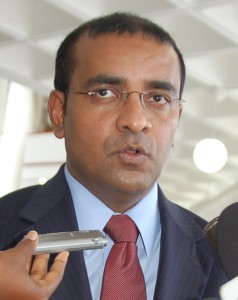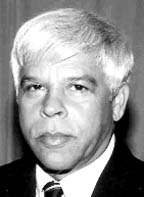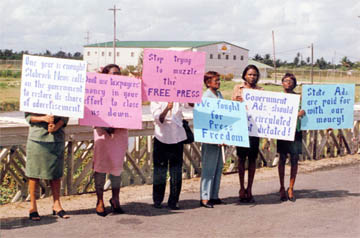How will President Bharrat Jagdeo’s ten-year tenure of office be remembered? A war is being waged to ensure that the media’s record justifies the president’s policies.

Denying state advertisements to the Stabroek News; banning a Capitol News journalist from attending press conferences at the Office of the President; shutting down a television station for four months; politicising the state-owned news media and maintaining a state monopoly on radio broadcasting are all part of the campaign to ensure that a favourable version of current events prevails might appear to be random reactions to provocative situations. In reality, however, these are all weapons in the war to secure the president’s place in history and to cement his legacy in the public memory.
Virtual minister
To better understand President Bharrat Jagdeo’s attitude to the media, it must be realised that, indeed, he is the Minister of Information. Under the law, any portfolio not specifically assigned to another minister falls to the president; even though the ministry is a virtual one, the power he wields is real. It was as Minister of Information, therefore, that back in May 2002 Mr Jagdeo signed the Declaration of Chapultepec, emphasising his administration’s commitment to freedom of the press and free speech.
Mr Jagdeo said then that his endorsement of the Declaration should be a source of assurance to the local media corps that it has nothing to fear from his administration. “My government has never, and will never, seek to victimise, punish or in any way target media organisations simply because they do not share the government’s view on an issue. Such behaviour would be reprehensible to me personally….” he said at that time.
Adhesion to the Declaration was reinforced by the signing of the Media Code of Conduct in January 2006 when several media organisations, including those owned by the state, made a committment to provide equitable coverage of the forthcoming elections. According to the Code:
“The Media, in accepting the principle of fair and balanced reporting, recognise that no story is fair, if it omits facts of major importance or significance and is therefore incomplete; includes essentially irrelevant information, rumour or unsubstantiated statements at the expense of significant facts and if it consciously or unconsciously misleads or even deceives the reader, listener or viewer.”
It is as Minister of Information, and with the background of the Declaration and the Code that Mr Jagdeo’s official and personal control of the state media must be interpreted. The media troika − the Government Information Agency; Guyana National Newspapers Limited; and National Communications Network − are, therefore, all within the president’s portfolio. Here, the level of coordination of state media policy is superb. The NCN and GINA occupy adjacent premises in the same compound. A close reading of GNNL’s Guyana Chronicle also displays an uncritical reproduction of GINA’s statements. The state media are signatories to the Media Code of Conduct but, when the independent Media Monitoring Unit monitored the content of NCN and GINA’s output, it came to the conclusion that so-called state information often took the form of People’s Progressive Party-Civic political propaganda.

This reality was scandalously manifested in July 2006 at the PPP/C’s election rally in Berbice when some GINA staff showed up wearing PPPC campaign apparel. Even the Kaieteur News newspaper editorialised: “There for all to see…were some employees of the state media sporting jerseys and caps proclaiming their support for and loyalty to the ruling party.” In commenting on the issue, Mr Jagdeo said that the journalists could still discharge their responsibilities in an objective manner since their political beliefs differed from writing and, anyway this was “a free country.” Would he have said the same if GINA staff showed up in PNC or AFC campaign apparel?
The Media Monitoring Unit also referred to several programmes − The President’s Diary, The Fact, Weekly Digest, and GINA Features − as having “clearly political content and elements of partisan political campaigning in the guise of government business.” As the campaign proceeded to election day, the MMU’s content analysis of NCN and GINA found “increasing imbalance favouring the ruling party over the opposition, reaching 20 to one on VOG radio.”
Enemies of the president
Mr Jagdeo might imagine himself as the heir to Dr Cheddi Jagan’s iconic legacy and lofty reputation. For this reason, Mr Jagdeo’s choice of the annual Cheddi Jagan commemoration ceremonies at the memorial site on the Corentyne contain numerous clues to his self image.
At this year’s ceremony in March, for example, Mr Jagdeo criticised journalists for not reporting the news accurately and for distorting the facts to make the government look bad, labelling them the “new opposition.” He claimed that some reporters seemed to go to press conferences to “coordinate their questions” and that, “no matter how much information you give, their job is to go back, take something and distort it…some do that because of lack of understanding or to make the government look bad…They are the new opposition.” He said, too, that in many cases, the news is just “fabricated or misleading because they want to evoke a response. Some of the newspapers even carry misleading headlines so that the government would then respond to the headline and then they have something else to write about.”

Mr Jagdeo reserves much of his anger for responding to persons who attack his own credibility. Referring to the banning of Capitol News reporter Gordon Moseley from the Office of the President and State House last year, Mr Jagdeo admitted that the reporter was censured because he produced a news item that was critical of him. He dismissed him saying, “I don’t have time to waste on people like Gordon Moseley. Access to this office is a privilege and I will extend that privilege to ordinary people, not to some people who, regardless of what you do, only see the negatives and they’re looking for the next story.”
Mr Jagdeo also attacked the Guyana Press Association which, he said, “demonstrated its bias against the government on numerous occasions. In fact, it is even more hostile to the government than the opposition party. It is like the new opposition in Guyana and they consistently mislead the international community. They did this on several occasions.”
The attack on the Stabroek News, similarly, arose from personal, not political, causes. In December 2007, Stabroek News editor Anand Persaud while in Jamaica to attend a seminar on press freedom and corruption prevention, told The Gleaner that the Stabroek News was facing the wrath of the administration, which had withdrawn all advertisements since November 2006. Persaud said “This move was preceded by withering attacks by President Bharrat Jagdeo on the editor-in-chief of the newspaper.” Mr Jagdeo criticised the newspaper accusing it of “supporting a third party…this move is to penalise the newspaper for critical reporting.” He said the government’s decision seemed to be a message to the daily that it should soften its stance, an action Stabroek News chose not to take. The Commonwealth Press Union (CPU) and the Inter American Press Association (IAPA) have also criticised the Jagdeo administration for this act of hostility.
The campaign against the Stabroek News indeed had arisen out of the personal controversy between Mr Jagdeo and two members of the PPPC Central Committee – Moses Nagamootoo and Khemraj Ramjattan – who made certain claims about an incident which occurred in January 2004. Stabroek News carried the story but the claims were denied and an attorney-at-law acting for Mr Jagdeo dispatched a letter to the Stabroek News seeking an unqualified apology or retraction and threatening legal action. David de Caires informed the attorney-at-Law that he would not apologise and was prepared to defend the matter in court.
Mr Ramjattan was subsequently expelled from the PPP but, in the spirit of encouraging freedom of expression, David de Caires allowed him and Mr Raphael Trotman, who had also left the People’s National Congress, to write a regular series of articles in the Stabroek News. Although the articles were discontinued when Mr Ramjattan and Mr Trotman launched a new political party – the Alliance for Change – to contest the general elections, the newspaper was regarded as “supporting a third party” to challenge the ruling party. Not three months after the 2006 general elections, therefore, government advertisements to the Stabroek News were abruptly withdrawn. State advertisements, which are centrally controlled by government’s virtual ministry of information, were restored only on the eve of the establishment of another newspaper which would be given a share of state advertising.
Again, it was as virtual Minister of Information that Mr Jagdeo personally suspended the licence of CNS Channel 6. The station was accused of repeating a broadcast in February and March 2008 of which Mr Jagdeo was the subject of a briel telephone conversation. The Advisory Committee on Broadcasting deemed that conversation “an incitement to crime, was offensive to public feeling, was offensive to good taste, was presented without due accuracy and attempted to trivialise serious statements made by the Head of State.” As a result, the Minister – Mr Jagdeo himself – decided that the licence would be suspended for four months with effect from midnight on 11th April 2008.
The war over memory
As Mr Jagdeo prepares to celebrate his tenth year as president, an office that he must demit in two year’s time, he is deeply concerned about how he will be remembered. His control of the state media has ensured their docile compliance. The independent media, however, continue to pose problems. Failing to win them over, he has attacked them for alleged, but unsubstantiated, compliance with the opposition.
For example, in one of his most bitter attacks in January 2004, he criticised the media, particularly the Stabroek News, at a community meeting in Annandale. Preposterous-ly linking the media with the Opposition People’s National Congress-Reform in the death squad controversy involving Minister of Home Affairs Mr Ronald Gajraj, Mr Jagdeo said then, “what we have today is a campaign by the media joining with the PNC to bring the government down and this is not gong to change… for ten years we have had to face it… and the only thing time they will be satisfied with is when the PPP leaves office.”
This sort of performance plays well with the constituents who probably see the president and their party as victims of some sort of media conspiracy.
Mr Jagdeo wants to live in the memory of the Guyanese nation as the president who brought economic growth, social stability and public security. It is a delusion to believe that this could be achieved with the uncritical stuff that is peddled by the state media and by attempting to intimidate the independent media. To do so would be playing a dangerous game with the future and the recent past of this country.
